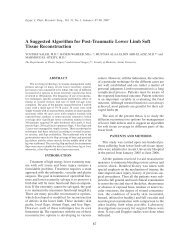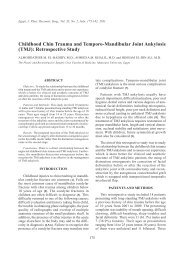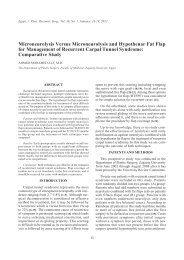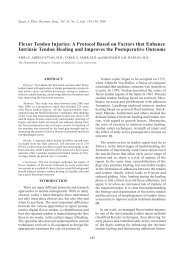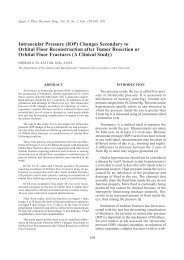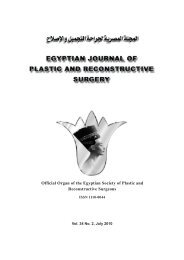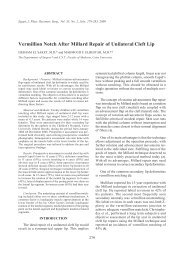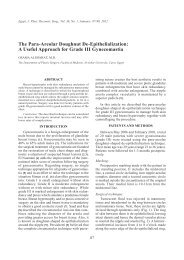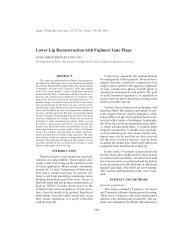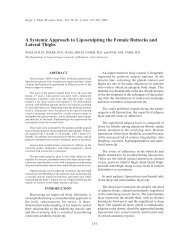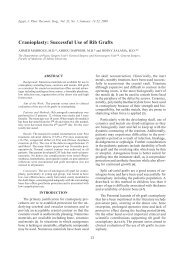Polydactyly: Surgical Strategy and Clinical Experience with ... - ESPRS
Polydactyly: Surgical Strategy and Clinical Experience with ... - ESPRS
Polydactyly: Surgical Strategy and Clinical Experience with ... - ESPRS
You also want an ePaper? Increase the reach of your titles
YUMPU automatically turns print PDFs into web optimized ePapers that Google loves.
Egypt, J. Plast. Reconstr. Surg., Vol. 35, No. 2, July: 287-300, 2011<br />
<strong>Polydactyly</strong>: <strong>Surgical</strong> <strong>Strategy</strong> <strong>and</strong> <strong>Clinical</strong> <strong>Experience</strong> <strong>with</strong> 40 Cases<br />
EHAB FOUAD ZAYED, M.D. 1; TAREK M. ELBANOBY, M.D. 2; WAEL AYAD, M.D. 3 <strong>and</strong><br />
ABDUL-HAMEED M. EL-SHISHTAWY, M.Sc.<br />
The Departments of Plastic & Reconstructive Surgery, Tanta 1 & Al Azhar 2,3 Universities<br />
ABSTRACT<br />
<strong>Polydactyly</strong> is the most common congenital digital anomaly<br />
of the h<strong>and</strong> <strong>and</strong> foot. It may appear in isolation or in<br />
association <strong>with</strong> other birth defects. <strong>Polydactyly</strong> can vary<br />
from unnoticeable rudimentary finger or toe to a fully developed<br />
extra digit. Surgery on polydactyly is rewarding. Various<br />
classification categories can be used as a guide for treatment,<br />
although they can’t be considered as a prognostic tool to<br />
assess post operative results.<br />
Forty patients <strong>with</strong> 48 polydactyly were operated. The<br />
age of patients at the time of operation ranged from one day<br />
to 47 years. Twenty-six patients presented <strong>with</strong> polydactyly<br />
of the h<strong>and</strong>; 15 patients <strong>with</strong> preaxial, 10 patients <strong>with</strong> postaxial<br />
polydactyly, <strong>and</strong> one patient presented <strong>with</strong> central polydactyly<br />
(synpolydactyly). Fourteen patients <strong>with</strong> foot polydactyly;<br />
out of which 8 patients <strong>with</strong> postaxial <strong>and</strong> 6 patients presented<br />
<strong>with</strong> preaxial foot polydactyly. Four patients had bilateral<br />
h<strong>and</strong> involvement (3 cases type B <strong>and</strong> one type A ulnar<br />
polydactyly), one patient presented <strong>with</strong> bilateral foot preaxial<br />
polydactyly <strong>and</strong> one patient presented <strong>with</strong> bilateral polydactyly<br />
both h<strong>and</strong>s <strong>and</strong> feet. More than 82% of the patients were<br />
satisfied or very satisfied <strong>with</strong> functional <strong>and</strong> cosmetic outcomes.<br />
Postoperative complications such as scar hypertrophy,<br />
pulp atrophy, painful neuroma, joint deformity <strong>and</strong> instability<br />
were common but minor. The main purpose of this study is<br />
to evaluate clinical <strong>and</strong> cosmetic outcomes of surgical correction<br />
of polydactyly of h<strong>and</strong>s <strong>and</strong> feet, in comparison <strong>with</strong><br />
other studies.<br />
INTRODUCTION<br />
<strong>Polydactyly</strong> means the presence of more than<br />
the normal number of fingers or toes. It is also<br />
called polydactylism, polydactylia or hyperdactyly.<br />
It can vary from unnoticeable rudimentary finger<br />
or toe to fully developed extra digit. It can occur<br />
simultaneously <strong>with</strong> syndactyly <strong>and</strong> known as<br />
polysyndactyly or synpolydactyly. It can occur as<br />
an isolated congenital anomaly or as one aspect of<br />
multi-symptom disease or syndrome [1].<br />
<strong>Polydactyly</strong> is the most common congenital<br />
digital anomaly of the h<strong>and</strong> <strong>and</strong> foot. Frequency<br />
is variable among populations. H<strong>and</strong> post axial<br />
polydactyly is more frequent (75%) then foot post<br />
axial polydactyly (15%) <strong>and</strong> is less often found<br />
287<br />
<strong>with</strong> other anomalies (7% versus 15%). Both h<strong>and</strong><br />
<strong>and</strong> foot post axial polydactyly is the least frequent<br />
occurrence (10%) [2].<br />
H<strong>and</strong> polydactyly:<br />
Thumb polydactyly:<br />
Thumb polydactyly is the most common type<br />
of polydactyly in the h<strong>and</strong>. It is believed to arise<br />
from excessive cell proliferation <strong>and</strong> disturbed cell<br />
necrosis of pre-axial ectodermal <strong>and</strong> mesodermal<br />
tissues before the eighth week of embryonic life<br />
[3]. It occurs sporadically <strong>with</strong> an incidence of 8<br />
in 100,000 in both black <strong>and</strong> white populations<br />
[4,5]. Hereditary influence has not been documented<br />
in isolated thumb polydactyly, although Ezaki [4]<br />
found its association in several syndromes. Autosomal<br />
dominance has been reported only in triphalangism<br />
<strong>and</strong> polysyndactyly.<br />
Currently, the Wassel classification [6] is universally<br />
accepted to categorize the pathoanatomy<br />
of thumb polydactyly <strong>and</strong> to guide respective<br />
surgical procedures. This classification categorizes<br />
thumb polydactyly into 7 groups based on the level<br />
of duplications; Type I: Bifid distal phalanx (DP),<br />
Type II: Duplicated DP, Type III: Bifid proximal<br />
phalanx (PP), Type IV: Most common type <strong>with</strong><br />
duplication of proximal phalanx which rests on<br />
broad metacarpal, Type V: bifid metacarpal (MC),<br />
Type VI: Duplic-ated MC <strong>and</strong> Type VII: Triphalangism.<br />
Operation remains the definitive treatment <strong>with</strong><br />
a goal to improve cosmesis <strong>and</strong> possibly h<strong>and</strong><br />
function [6-8]. Since Bilhaut first described an<br />
operation for thumb polydactyly in 1890, different<br />
surgical procedures have been reported [9-11]. It is<br />
important to evaluate <strong>and</strong> treat the skin, nail, bone,<br />
<strong>and</strong> the ligaments in a simultaneous manner in<br />
order to obtain a good reconstru-ction <strong>and</strong> to decrease<br />
both the complications <strong>and</strong> the need for<br />
subsequent operations [12].
288 Vol. 35, No. 2 / <strong>Polydactyly</strong>; <strong>Surgical</strong> <strong>Strategy</strong> & <strong>Clinical</strong> <strong>Experience</strong><br />
Ulnar polydactyly:<br />
Postaxial polydactyly involves the fifth digit<br />
or ray, either isolate, or more commonly, as one<br />
feature of a syndrome of congenital anomalies.<br />
Postaxial polydactyly is approximately 10 times<br />
more frequent in blacks <strong>and</strong> is more frequent in<br />
male children. In contrast, postaxial polydactyly<br />
seen in white children is usually syndromic <strong>and</strong><br />
associated <strong>with</strong> autosomal recessive transmission.<br />
Post-axial polydactyly in both h<strong>and</strong>s is very rare<br />
<strong>and</strong> along <strong>with</strong> one foot is even rarer [13].<br />
Temtamy <strong>and</strong> McKusick [14] offered a genetically<br />
based classification after noting that parents <strong>with</strong><br />
Type A polydactyly can have children <strong>with</strong> either<br />
Type A or B ulnar polydactyly, while children of<br />
persons <strong>with</strong> Type B can have only Type B polydactyly.<br />
Both types are usually inherited as an autosomal<br />
dominant <strong>and</strong> recent studies have identified the<br />
responsible loci on chromosomes 7, 13 <strong>and</strong> 19 [13],<br />
many surgeons have considered this classification<br />
too simplistic <strong>and</strong> prefer using the Stelling classification<br />
[15], which is based on the necessary management.<br />
This classification did not gain popularity because<br />
it does not describe the pedunculated type adequately,<br />
which is a major disadvantage since the pedunculated<br />
type is the most common in all races. Light [16]<br />
recommended using ‘‘Universal’’ classification initially<br />
described by Buck-Gramcko <strong>and</strong> Behrens [17].<br />
The term ‘‘Universal’’ means that the classification<br />
may be applied to all forms of polydactyly (little<br />
finger, central <strong>and</strong> thumb polydactyly). More recently,<br />
Rayan <strong>and</strong> Frey (2001) [18] extended the Stelling<br />
classification into five types (Table 1).<br />
The options for treatment of postaxial polydactyly<br />
depend on the characteristics of the extra digit. If it<br />
is rudimentary <strong>and</strong> pedunculated (type B), its base<br />
can be tied <strong>with</strong> a suture in the newborn period, <strong>and</strong><br />
it will fall off spontaneously. This procedure sometimes<br />
leave a ‘residual bump’ at the base [19].<br />
Better developed extra digits (type A), especially<br />
those containing bone or cartilage, can be corrected<br />
<strong>with</strong> surgery. This procedure is usually done during<br />
the first year of life [20].<br />
Central polydactyly:<br />
Central polydactyly is an extra digit <strong>with</strong>in the<br />
h<strong>and</strong> <strong>and</strong> not along its borders. Central polydactyly<br />
is uncommon compared <strong>with</strong> border polydactyly [21].<br />
The ring digit is the most common duplication,<br />
followed by the long finger, <strong>and</strong> lastly the index digit.<br />
Central polydactyly occurs in isolation or is part of<br />
a syndrome. The central polydactyly may be hidden<br />
<strong>with</strong>in a concomitant syndactyly (i.e., synpolydactyly).<br />
Identification of synpolydactyly requires careful<br />
examination supplemented by radiographic verification.<br />
<strong>Polydactyly</strong> of the foot:<br />
<strong>Polydactyly</strong> is a fairly common congenital condition<br />
of the foot <strong>and</strong> is characterized by the presence<br />
of supernumerary toes. Digital duplications range<br />
from boneless soft tissue structures to incomplete or<br />
complete bony duplications. Postaxial polydactyly<br />
accounts for about 80% of foot polydactyly while<br />
preaxial polydactyly accounts for about 15-17% of<br />
foot polydactyly cases <strong>and</strong> central polydactyly accounts<br />
for about 3-6% of foot polydactyly cases. The<br />
duplication may appear at the distal <strong>and</strong> middle<br />
phalanges or at the whole digit <strong>and</strong> metatarsal [22].<br />
The classification systems used for foot polydactyly<br />
have been primarily based on morphology. Polydactylous<br />
manifestations are described according to<br />
their anatomical location on the proximal, intermediate,<br />
or distal segments of the foot. Temtamy <strong>and</strong><br />
McKusick’s [14] classification described polydactyly<br />
based on the location of the extra digits : medial ray<br />
(preaxial), central ray <strong>and</strong> lateral ray (postaxial) <strong>with</strong><br />
the postaxial type A referring to a fully developed<br />
digit <strong>and</strong> type B to a rudimentary digit.<br />
Venn-Watson [22] further subdivided post-axial<br />
duplication according to the morphologic presentation<br />
of the accessory ray. Four metatarsal patterns were<br />
noted: soft-tissue duplication, wide metatarsal head,<br />
Y-shaped metatarsal <strong>and</strong> complete duplication. Blauth<br />
<strong>and</strong> Olason [1] took into consideration the many<br />
variable presentations of polydactyly of the foot <strong>and</strong><br />
h<strong>and</strong>. The classification was based on the position<br />
of duplication on both the longitudinal <strong>and</strong> transverse<br />
plane. The longitudinal nomenclature is based on<br />
duplication of a phalanx or ray from distal to proximal.<br />
The transverse arrangement of the classification<br />
indicates which rays were involved in the duplication.<br />
It is classified according to Roman numerals <strong>with</strong><br />
the first digit starting on the tibial side <strong>and</strong> increasing<br />
laterally. Lastly, Watanabe et al. [23] reported an<br />
analysis of 265 cases <strong>and</strong> a morphological classification<br />
by type of ray involvement <strong>and</strong> level of duplication.<br />
The anatomic pattern types in medial ray polydactyly<br />
are tarsal, metatarsal, proximal <strong>and</strong> distal<br />
phalangeal. Central ray pattern types are metatarsal,<br />
proximal, middle <strong>and</strong> distal phalangeal. Lateral ray<br />
polydactyly was further divided into fifth ray duplication<br />
(medial supernumerary toe) <strong>and</strong> sixth ray<br />
duplication (lateral supernumerary toe).<br />
Treatment of foot polydactyly may be indicated<br />
for shoe problems, pain or cosmetic reasons. Surgery<br />
is generally done before walking age, when the infant<br />
is between 9 <strong>and</strong> 12 months of age. Adult cases are
Egypt, J. Plast. Reconstr. Surg., July 2011 289<br />
rarer, <strong>and</strong> surgical management of the deformity is<br />
still debated [24].<br />
PATIENTS AND METHODS<br />
This work included forty patients <strong>with</strong> fortyeight<br />
polydactylies. Twenty-six patients were males<br />
<strong>and</strong> 14 were females <strong>and</strong> their age at the time of<br />
operation ranged from one day to 47 years.<br />
Twenty-six patients presented <strong>with</strong> polydactyly<br />
of the h<strong>and</strong>; 15 patients <strong>with</strong> preaxial polydactyly<br />
(10 cases type IV, 3 cases type III <strong>and</strong> 2 cases type<br />
VI according to Wassel classification [6]), ten<br />
patients <strong>with</strong> postaxial polydactyly (4 cases type<br />
A <strong>and</strong> 6 cases type B according to Temtamy <strong>and</strong><br />
McKusick classification [14]) <strong>and</strong> only one patient<br />
presented <strong>with</strong> central polydactyly <strong>with</strong> complex<br />
syndactyly. Four patients had bilateral h<strong>and</strong> involvement<br />
(3 cases type B <strong>and</strong> one type A ulnar<br />
polydactyly).<br />
Fourteen patients <strong>with</strong> foot polydactyly; out of<br />
which 8 patients presented <strong>with</strong> postaxial <strong>and</strong> 6<br />
patients <strong>with</strong> preaxial foot polydactyly. One patient<br />
presented <strong>with</strong> bilateral foot preaxial polydactyly<br />
together <strong>with</strong> simple complete syndactyly i.e.<br />
synpolydactyly, <strong>and</strong> one patient presented <strong>with</strong><br />
bilateral polydactyly both h<strong>and</strong>s <strong>and</strong> feet.<br />
<strong>Surgical</strong> strategy:<br />
In general, ablasion of the extra fingers or toes<br />
was the principal surgery. <strong>Surgical</strong> correction can<br />
be done at any age if the anesthesia can be tolerated.<br />
For h<strong>and</strong> polydactyly; earlier treatment gives better<br />
result, usually during the first year of life, however,<br />
treatment of foot polydactyly is generally done<br />
before walking age, between the age of 9 <strong>and</strong> 12<br />
months.<br />
H<strong>and</strong> polydactyly:<br />
<strong>Surgical</strong> strategy was to remove the hypoplastic<br />
or malpositioned finger <strong>and</strong> to augment thumb<br />
reconstruction <strong>with</strong> tissues borrowed from the<br />
accessory digit. If there are two equal digits, we<br />
chose to remove the radial digit <strong>and</strong> reconstruct<br />
the radial collateral ligament rather than the ulnar<br />
collateral ligament. Duplicated extensor pollicis<br />
longus <strong>and</strong> flexor pollicis longus should be transferred<br />
over to the remaining digits. Abductor brevis<br />
is transferred along <strong>with</strong> its periosteum to an anatomic<br />
insertion site on the other digit just distal to<br />
the epiphysis. Alternatively, the abductor brevis<br />
can be transferred over <strong>with</strong> a small piece of bone<br />
(requires a K-wire for fixation). If web space may<br />
be contracted, the dorsal skin from the discarded<br />
digit should be used to assist <strong>with</strong> web space<br />
deepening. Importantly, in elderly patients, if there’s<br />
manifest angulations of the digit, corrective osteotomies<br />
should be carried out to regain the normal<br />
finger alignment. Chondroplasty is usually performed<br />
to trim down the size of the articulating<br />
surface in order to restore joint stability, mobility,<br />
<strong>and</strong> axial alignment.<br />
The options for primary treatment of postaxial<br />
type B polydactyly include no intervention, string<br />
ligation, <strong>and</strong> surgical amputation. While many<br />
cases of ulnar polydactyly can be treated nonsurgically,<br />
a significant subset would benefit from a<br />
procedure directed at eliminating the need for<br />
subsequent revisions for incomplete amputation<br />
or painful neuroma. The indications for primary<br />
surgical intervention would include presence of a<br />
bony or ligamentous attachment (type A), or presence<br />
of a wide digital base (more than 2mm).<br />
Treatment of central polydactyly depends on<br />
the status <strong>and</strong> extent of the extra digit <strong>and</strong> the<br />
presence or absence of concurrent anomalies, such<br />
as syndactyly. A central polydactyly that has a fully<br />
formed digit <strong>and</strong> normal function does not require<br />
removal to restore the normal complement of digits.<br />
An isolated central polydactyly <strong>with</strong> limited motion<br />
of the extra digit is treated <strong>with</strong> ray resection. The<br />
span of the h<strong>and</strong> is maintained by transposition of<br />
adjacent digits <strong>and</strong>/or intermetacarpal ligament<br />
reconstruction.<br />
Synpolydactyly is treated <strong>with</strong> syndactyly separation<br />
<strong>and</strong> reduction of the concealed polydactyly.<br />
Complete removal of the redundant bones, however,<br />
is difficult to accomplish <strong>with</strong>out jeopardizing joint<br />
structure or digital circulation. Partial central<br />
polydactyly is treated <strong>with</strong> similar principles used<br />
to reconstruct the duplicated thumb.<br />
Foot polydactyly:<br />
The general surgical goal is to excise the toe<br />
which provides the foot <strong>with</strong> the most normal<br />
contour, usually this involves excision of the most<br />
medial or the most lateral toe, depending on whether<br />
the deformity is pre, or postaxial.<br />
In the foot preaxial group, the tibial side toe<br />
was usually removed <strong>with</strong> disarticulation, trimming<br />
of the wide metatarsal head, capsular repair <strong>and</strong><br />
reinsertion of abductor, adductor, flexor or extensor<br />
hallucis tendons.<br />
Patients <strong>with</strong> central polydactyly of the foot<br />
often have a widened forefoot (splayed) which is<br />
often cannot be corrected <strong>with</strong> surgical removal<br />
of the duplicated digits. This results from laxity<br />
of the intermetatarsal ligament. Surgery involves<br />
removing the central ray duplications through a
290 Vol. 35, No. 2 / <strong>Polydactyly</strong>; <strong>Surgical</strong> <strong>Strategy</strong> & <strong>Clinical</strong> <strong>Experience</strong><br />
dorsal racquet-shape incision at the base of the<br />
duplication, excision of the toe, <strong>and</strong> re–approximation<br />
of the intermetatarsal ligament.<br />
In postaxial group, excision of the most lateral<br />
toe or simple amputation of the deformity toes was<br />
performed. If the metatarsal head is prominent, it<br />
should be trimmed flush to the metatarsal shaft (at<br />
right angles to the physis). Leaving the metatarsal<br />
head prominent may cause a painful postoperative<br />
bunion. The metatarsal bowing which results from<br />
excision of a “Y” metatarsal will usually remodels<br />
over several years. The joint capsule should be<br />
carefully repaired.<br />
Cases presentation:<br />
Case I:<br />
A three year old girl presented <strong>with</strong> right h<strong>and</strong><br />
type IV preaxial polydactyly (Fig. 1). Ablasion of<br />
the duplicated thumb on the radial side <strong>and</strong> augmentation<br />
of the remaining digit <strong>with</strong> soft tissue<br />
borrowed from the amputated finger were done<br />
together <strong>with</strong> repair of the radial collateral ligament<br />
of the metacarpophalangeal joint <strong>and</strong> K-wire fixation.<br />
Case II:<br />
A five year old girl presented <strong>with</strong> left h<strong>and</strong><br />
type IV thumb polydactyly (Fig. 2), <strong>with</strong> simple<br />
incomplete syndactyly between the two digits, i.e.<br />
synpolydactyly. Ablasion of the extra digit on the<br />
radial side was done. Augmentation of the remaining<br />
digit <strong>with</strong> soft tissues from the removed one,<br />
repair of the metacarpophalangeal joint <strong>and</strong> Kwire<br />
fixation were carried out.<br />
Case III:<br />
A 33 year old gentleman presented <strong>with</strong> right<br />
h<strong>and</strong> type IV thumb synpolydactyly (Fig. 3). We<br />
removed the radial side digit <strong>and</strong> re-enforced the<br />
extensor pollicis tendon from the excised finger<br />
<strong>and</strong> repaired the metacarpophalangeal joint. Kwire<br />
fixation was done to maintain the normal<br />
alignment.<br />
Case IV:<br />
A three year old boy presented <strong>with</strong> left h<strong>and</strong><br />
type VI thumb polydactyly (Fig. 4). Ablasion of<br />
the extra digit <strong>and</strong> repair of the carpo-metacarpal<br />
joint were done <strong>with</strong> a satisfactory result.<br />
Case V:<br />
A 13 year old girl presented <strong>with</strong> Z-thumb<br />
deformity in a type II polydactyly. The patient had<br />
undergone the first operation elsewhere <strong>and</strong> presented<br />
to our department ten years later. The exact<br />
nature of that operation was unknown but Z thumb<br />
deformity was present; there was a tight capsule<br />
<strong>and</strong> scarring in the radial collateral ligament <strong>and</strong><br />
an eccentric pull of the malaligned flexor pollicis<br />
longus tendon. Release of scarred tissue on the<br />
radial side, re-alignment of the extensor pollicis<br />
longus tendon, lengthening of the flexor pollicis<br />
longus tendon <strong>and</strong> K-wire fixation were performed,<br />
<strong>with</strong> satisfactory cosmetic & functional recovery<br />
(Fig. 5).<br />
Case VI:<br />
A two year old girl presented <strong>with</strong> left h<strong>and</strong><br />
type A postaxial polydactyly (Fig. 6). Ablating the<br />
ulnar digit, re-insertion of the abductor digiti<br />
minimi muscle, <strong>and</strong> repair of the common metacarpophalangeal<br />
joint were carried out.<br />
Case VII:<br />
A fourteen year old boy presented <strong>with</strong> bilateral<br />
type A ulnar polydactyly (Fig. 7) <strong>with</strong> Y-shaped<br />
fifth metacarpal (more on right h<strong>and</strong>). Ablasion of<br />
the lateral most fingers, trimming of the Ymetacarpal,<br />
<strong>and</strong> repair of metacarpophalangeal<br />
joints done <strong>with</strong> satisfactory result.<br />
Case VIII:<br />
A fifteen month old boy presented <strong>with</strong> bilateral<br />
postaxial polydactyly of both h<strong>and</strong>s <strong>and</strong> feet (Fig.<br />
8). The duplicated ulnar fingers <strong>and</strong> the outermost<br />
supernumerary toes were removed <strong>and</strong> repair of<br />
the metacarpophal-angeal <strong>and</strong> metatarsophalangeal<br />
joints were carried out <strong>with</strong> satisfactory results.<br />
Case IX:<br />
A thirteen month old baby presented <strong>with</strong> right<br />
h<strong>and</strong> central polydactyly associated <strong>with</strong> complex<br />
syndactyly; complex synpolydactyly (Fig. 9). Resection<br />
of the extra digit, release of syndactyly <strong>and</strong><br />
repair of the middle <strong>and</strong> ring fingers were done<br />
together <strong>with</strong> K-wire fixation.<br />
Case X:<br />
A thirteen year old girl presented <strong>with</strong> left big<br />
toe polydactyly (Fig. 10). Both digits were articulating<br />
at the same metatarso-phalangeal (MTP)<br />
joint <strong>with</strong> two articulating facets <strong>and</strong> severe hallux<br />
valgus. The supernumerary toe on the tibial side<br />
was removed together <strong>with</strong> re-attachment of the<br />
abductor <strong>and</strong> extensor hallucis tendons. Because<br />
there was manifest angulation at the first MTP<br />
joint, wedge osteotomy of the first metatarsal bone<br />
was done <strong>and</strong> fixation <strong>with</strong> K-wire was carried out<br />
to retain the normal alignment of the MTP joint.<br />
CASE XI:<br />
An eight year old boy presented <strong>with</strong> left foot<br />
postaxial polydactyly (Fig. 11), <strong>with</strong> simple com-
Egypt, J. Plast. Reconstr. Surg., July 2011 291<br />
plete syndactyly between the fifth <strong>and</strong> sixth digits,<br />
i.e. synpolydactyly. For this patient we chose to<br />
remove the tibial side toe because it was hypoplastic<br />
though it was not the outermost toe. Tightening of<br />
the collateral ligament of the metatarsophalangeal<br />
joint <strong>and</strong> external finger splint was enough to keep<br />
the normal contour of the foot on long term result.<br />
RESULTS<br />
This study comprised 26 male <strong>and</strong> 14 female<br />
patients <strong>with</strong> 48 polydactylies. There was no perioperative<br />
mortality or wound infection. Patients<br />
<strong>with</strong> thumb polydactyly were assessed using Tada<br />
score [25], <strong>and</strong> patients <strong>with</strong> foot polydactyly were<br />
evaluated <strong>with</strong> Phleps-Gorgan [26] protocol. More<br />
than 82% of the patients were satisfied or very<br />
satisfied <strong>with</strong> functional <strong>and</strong> cosmetic outcomes.<br />
H<strong>and</strong> polydactyly:<br />
Fifteen patients presented <strong>with</strong> thumb polydactyly,<br />
ten patients <strong>with</strong> postaxial polydactyly <strong>and</strong><br />
one patient presented <strong>with</strong> central polydactyly of<br />
the h<strong>and</strong>.<br />
Patients <strong>with</strong> thumb polydactyly were evaluated<br />
clinically according to Tada score [25]. That<br />
score is a comprehensive tool, which has been<br />
validated in the assessment of surgical outcomes<br />
of thumb polydactyly, as it takes cosmesis, functional,<br />
<strong>and</strong> radiographic evaluations into account.<br />
Thumb strength is mostly dependent on joint stability<br />
<strong>and</strong> muscle power. It is difficult to assess<br />
grip <strong>and</strong> pinch strength in very young patients, as<br />
they are either too weak to perform the test or too<br />
immature to follow instructtions. Its significance<br />
in clinical documentation in the very young agegroup<br />
is doubtful. Assessment specifically addressed<br />
first web contracture <strong>and</strong> bone growth.<br />
Evaluation of growth potential, instability, <strong>and</strong><br />
deformity were performed clinically <strong>and</strong> radiologically.<br />
Seven patients developed post operative dissatisfaction;<br />
two patients showed hypertrophic scars<br />
managed conservatively, three patients developed<br />
joint instability <strong>and</strong> two patients showed digit<br />
angulations managed conservatively <strong>with</strong> adequate<br />
improvement. One patient, aged 11 years developed<br />
painful neuroma following excision of type-A ulnar<br />
polydactyly, revision done after 2 months <strong>with</strong><br />
adequate result.<br />
Foot polydactyly:<br />
Fourteen patients <strong>with</strong> foot polydactyly were<br />
operated; out of which 8 patients <strong>with</strong> postaxial<br />
<strong>and</strong> 6 patients presented <strong>with</strong> preaxial foot polydactyly.<br />
All foot polydactyly patients were evalu-<br />
ated <strong>with</strong> Phelps-Grogan’s protocol [26] (Table 2).<br />
Eleven patients were graded as excellent <strong>and</strong> three<br />
were categorized as good. Foot function <strong>and</strong> contour<br />
were restored to near normal after operation<br />
<strong>with</strong> minimal surgical scar <strong>and</strong> no patient complained<br />
of pain or callosity. Hallux varus was<br />
observed in 2 patients yet; all patients were able<br />
to wear shoes <strong>with</strong>out the necessity of modification,<br />
custom-made shoes, or pairing of different sizes.<br />
Table (1): Classification systems of ulnar polydactyly.<br />
Name of classification<br />
Temtamy-McKusick<br />
classification<br />
(Temtamy &<br />
McKusick, 1969) [14].<br />
Stelling classification<br />
(Stelling, 1963) [15].<br />
‘Universal’<br />
classification (Buck-<br />
Gramcko <strong>and</strong><br />
Behrens, 1989) [17].<br />
Rayan-Frey<br />
classification (Rayan<br />
<strong>and</strong> Frey, 2001) [18].<br />
Table (2): Phleps-Gorgan protocol [26].<br />
Criteria<br />
Pain<br />
Callosity<br />
Deformity of<br />
the remaining<br />
toes<br />
Scar cosmesis<br />
Excellent<br />
None<br />
None<br />
Not significant<br />
Satisfactory<br />
Description of the classification<br />
Type A: The extra digit is well<br />
formed <strong>and</strong> has an articulation<br />
Type B: The extra digit is poorly<br />
formed <strong>and</strong> is connected to the<br />
h<strong>and</strong> by a skin bridge<br />
I: Soft tissue only<br />
II: Duplication of the phalanges<br />
III: Complete duplication of the<br />
phalanges <strong>and</strong> metacarpal<br />
Soft tissue: Type V Rud<br />
(Rudimentary fifth digit)<br />
Bony: Type V distal phalanx, distal<br />
interphalangeal joint, middle<br />
phalanx, proximal interphalangeal<br />
joint, proximal phalanx,<br />
metacarpophalangeal joint,<br />
metacarpal, carpometa-carpal<br />
joint<br />
I: Soft tissue nubbin<br />
II: Pedunculated non-functioning<br />
digit<br />
III: A well formed functioning digit<br />
which is articulating <strong>with</strong> a bifid<br />
fifth metacarpal head or fused to<br />
the fifth metacarpal at a 90 angle<br />
IV: Complete duplication <strong>with</strong> a<br />
separate 6 th metacarpal<br />
V: Polysyndactyly (there is<br />
syndactyly between the little<br />
finger <strong>and</strong> its duplicate)<br />
Good<br />
Occasional<br />
Present but<br />
not painful<br />
Minimal<br />
Minimal<br />
complaint<br />
Poor<br />
Constant<br />
Constantly<br />
painful<br />
Marked<br />
Complaint
292 Vol. 35, No. 2 / <strong>Polydactyly</strong>; <strong>Surgical</strong> <strong>Strategy</strong> & <strong>Clinical</strong> <strong>Experience</strong><br />
Case I<br />
Fig. (1A): Right h<strong>and</strong> type IV thumb polydactyly.<br />
Fig. (1B): X-ray appearance.<br />
Fig. (1C): <strong>Surgical</strong> design.<br />
Fig. (1D): Re-insertion of extensor pollicis tendon <strong>and</strong> augmentation<br />
of the remaining digit <strong>with</strong> soft tissues<br />
from the ablated one.<br />
Fig. (1E): K-wire fixation.<br />
(G)<br />
(H)<br />
Fig. (1F): Post operative view.<br />
Fig. (1G,H): Precise grip few weeks after repair.<br />
Case II<br />
Fig. (2A): Left h<strong>and</strong>, type IV, thumb polydactyly, dorsal view.<br />
Fig. (2B): Left h<strong>and</strong>, type IV, thumb polydactyly, palmar view.
Egypt, J. Plast. Reconstr. Surg., July 2011 293<br />
Fig. (2C): Left h<strong>and</strong>, type IV, thumb polydactyly, X-ray view.<br />
Fig. (2D): Post operative X-ray view.<br />
Fig. (2E): Repair of the MP joint.<br />
Fig. (2F): K-wire fixation.<br />
Fig. (2G): Postoperative dorsal view.<br />
(A)<br />
(B)<br />
Fig. (2H): Postoperative palmar view.<br />
Case III<br />
Fig. (3A,B): Right h<strong>and</strong>, type IV thumb polydactyly.<br />
Fig. (3C): Preoperative X-ray view.<br />
Fig. (3D): The radial digit is removed <strong>and</strong> augmentation of<br />
the remaining finger together <strong>with</strong> repair of the<br />
MP joint of the thumb.
294 Vol. 35, No. 2 / <strong>Polydactyly</strong>; <strong>Surgical</strong> <strong>Strategy</strong> & <strong>Clinical</strong> <strong>Experience</strong><br />
Fig. (3E): Post operative appearance.<br />
Fig. (3F): Post operative appearance showing the precise grip.<br />
Fig. (3G): Post operative X-ray appearance.<br />
Fig. (3H): Post operative X-ray appearance showing the<br />
precise grip.<br />
Case IV<br />
Fig. (4A): Left h<strong>and</strong> type VI thumb polydactyly.<br />
Fig. (4B): Left h<strong>and</strong> type VI thumb polydactyly, preoperative<br />
marking.<br />
Fig. (4C): Post operative view (palmar side).<br />
Fig. (4D): Post operative view (scar site).<br />
Case V<br />
Fig. (5A): Z thumb.<br />
Fig. (5B): Release of scarred tissue, capsulorraphy, flexor<br />
pollicis lengthening, re-alignment of the proximal<br />
phalanx <strong>and</strong> K-wire fixation were done.
Egypt, J. Plast. Reconstr. Surg., July 2011 295<br />
Fig. (5C): Lengthening of the flexor pollicis <strong>and</strong> realignment<br />
of the extensor pollicis longus tendons.<br />
Fig. (5D): Postoperative result.<br />
Fig. (5E): Postoperative result.<br />
Case VI<br />
Fig. (6A): Left h<strong>and</strong> type A post-axial polydactyly.<br />
Fig. (6B): Re-insertion of the abductor digiti minimi muscle<br />
<strong>with</strong> the tendon of the removed digit.<br />
Fig. (6C): Early post operative view.<br />
Case VII<br />
Fig. (7A): Bilateral, type A, ulnar polydactyly.<br />
Fig. (7B): X-ray appearance.<br />
Fig. (7C): Post operative view.<br />
Fig. (7D): Post operative view.
296 Vol. 35, No. 2 / <strong>Polydactyly</strong>; <strong>Surgical</strong> <strong>Strategy</strong> & <strong>Clinical</strong> <strong>Experience</strong><br />
Case VIII<br />
Fig. (8A): Bilateral post-axial polydactyly both h<strong>and</strong>s.<br />
Fig. (8B): Bilateral post-axial polydactyly both feet.<br />
Fig. (8C): Post operative result.<br />
Fig. (8D): Post operative result.<br />
Case IX<br />
Fig. (9A): Right central polysyndactyly, preoperative presentation.<br />
Fig. (9B): Right central polysyndactyly, radiological appearance.<br />
Fig. (9C): Planning for release of syndactyly <strong>and</strong> excision of<br />
the central polydactyly.<br />
Fig. (9D): Post operative result few months later.<br />
(A)<br />
(B)<br />
Case X<br />
Fig. (10A,B): Left foot big toe polydactyly.
Egypt, J. Plast. Reconstr. Surg., July 2011 297<br />
Fig. (10C): X-ray view.<br />
Fig. (10D): Ablasion of the tibial digit, re-attachment of the<br />
extensor <strong>and</strong> abductor hallucis tendons, <strong>and</strong> wedge<br />
osteotomy of the 1 st metatarsal.<br />
Fig. (10E): K-wire fixation <strong>and</strong> repair of the MTP joint.<br />
Fig. (10F): Post operative X-ray.<br />
Fig. (10G): Post operative view.<br />
Case XI<br />
Fig. (11A): Left foot postaxial polydactyly <strong>and</strong> simple complete<br />
syndactyly i.e. synpolydactylt.<br />
Fig. (11B): Left foot postaxial polydactyly <strong>and</strong> simple complete<br />
syndactyly i.e. synpolydactylt.<br />
Fig. (11C): Radiological appearance.<br />
Fig. (11D): Radiological appearance (close up view).<br />
Fig. (11E): Early post operative view after ablasion of the<br />
tibial side toe.
298 Vol. 35, No. 2 / <strong>Polydactyly</strong>; <strong>Surgical</strong> <strong>Strategy</strong> & <strong>Clinical</strong> <strong>Experience</strong><br />
DISCUSSION<br />
<strong>Polydactyly</strong> is perhaps the most common congenital<br />
h<strong>and</strong> anomaly [13]. However, despite the<br />
extensive use of the developing limb as a classical<br />
developmental model, the cellular <strong>and</strong> genetic<br />
mechanisms that control the number <strong>and</strong> identity<br />
of the digits are not completely understood. Talamillo<br />
et al. [27]. With regards to the surgical<br />
correction of the polydactyly, is almost always<br />
indicated, not only for cosmetic improvement but<br />
also for better function.<br />
Surgery on thumb polydactyly is rewarding.<br />
The Wassel classification for thumb polydactyly<br />
was used for its simplicity for the purposes of<br />
clinical categorization <strong>and</strong> planning of surgical<br />
procedures [6]. Lister [28] has identified six qualities<br />
that provide the normal thumb <strong>with</strong> unique functional<br />
capabilities: (1) Length, (2) Stability, (3)<br />
Sensibility, (4) Mobility, (5) Dexterity, <strong>and</strong> (6)<br />
Power. Joint instability <strong>and</strong> angular deformity<br />
following thumb reconstruction is often due to<br />
nonparallel joint alignment [29,30], this occurs most<br />
often in types II <strong>and</strong> IV thumbs, in which a single<br />
proximal articular surface supports two distally<br />
diverging digits. It has recently been suggested<br />
that preoperative splinting may improve digital<br />
alignment <strong>and</strong> facilitate surgical reconstruction<br />
[31]. On surgical reconstruction, it is advisable to<br />
realign articular surfaces by osteotomy to establish<br />
proper axial alignment [32]. The interphalangeal<br />
<strong>and</strong> metacarpophalangeal joints should be realigned<br />
so that the joint line of each is perpendicular to<br />
the long axis of the metacarpal. Closing wedge<br />
metacarpal osteotomy is often indicated in type<br />
IV thumbs <strong>and</strong> may be simply fixed <strong>with</strong> the same<br />
longitudinal K-wire placed to maintain metacarpophalangeal<br />
joint congruency particularly in older<br />
child [32]. In our series two cases <strong>with</strong> type IV<br />
thumb polydactyly developed angular deformity<br />
partly improved <strong>with</strong> physiotherapy <strong>and</strong> finger<br />
Fig. (12) Fig. (13)<br />
Figs. (12,13): Gangrene of type B ulnar polydactyly.<br />
splinting. However osteotomies for younger patient<br />
are still controversial.<br />
<strong>Surgical</strong> treatment of central polydactyly is not<br />
rewarding [21], particularly if associated <strong>with</strong> complex<br />
bony fusion, yielding non satisfactory result.<br />
Function should be balanced <strong>with</strong> cosmetic result<br />
when operating on central polydactyly because the<br />
associated anomalies most probably limit the functional<br />
outcome.<br />
The options for primary treatment of postaxial<br />
type B h<strong>and</strong> polydactyly include no intervention,<br />
suture ligation, <strong>and</strong> surgical amputation. In the<br />
United Kingdom, a survey of pediatricians <strong>and</strong><br />
surgeons found that 79% of pediatricians <strong>and</strong> 67%<br />
of h<strong>and</strong> surgeons would advocate specialty referral<br />
for postaxial type B polydactyly <strong>with</strong> a narrow<br />
pedicle <strong>with</strong> the remainder recommendding suture<br />
ligation by pediatricians [33].<br />
Kanter <strong>and</strong> Upton [34] called the narrow pedicled,<br />
pedunculated polydactyly a ‘‘pacifier’’ polydactyly<br />
<strong>and</strong> they suggested that babies suck it in<br />
utero. They described three cases <strong>with</strong> imminent<br />
ischemic necrosis of the extra digit at birth. In our<br />
series two cases presented to us <strong>with</strong> gangrenous<br />
type B ulnar polydactyly <strong>with</strong>out apparent cause<br />
(Figs. 12,13), one infant was a new born <strong>and</strong> the<br />
other seen when he was one month old. <strong>Surgical</strong><br />
amputation of the extra-digit under short general<br />
anesthesia was done <strong>with</strong> good result.<br />
In the same survey mentioned above asking<br />
about treatment of postaxial type A polydactyly<br />
<strong>with</strong> an almost fully formed accessory finger <strong>with</strong><br />
a broad pedicle attachment, 99% of pediatricians<br />
<strong>and</strong> 97% of surgeons advoc-ated surgical specialist<br />
management [33], however the indications for primary<br />
surgical intervention for type A postaxial<br />
h<strong>and</strong> polydactyly would include presence of a bony<br />
or ligamentous attachment or presence of a wide<br />
digital base (more than 2mm).
Egypt, J. Plast. Reconstr. Surg., July 2011 299<br />
<strong>Polydactyly</strong> is a fairly common congenital<br />
condition of the foot. Several classifications [14,<br />
22,23] have been proposed in the literature to systematize<br />
this variable malformation.<br />
Surgery for foot polydactyly should not be<br />
delayed much beyond walking age to allow the<br />
maximum time for the bones to remodel. In most<br />
cases of postaxial polydactyly, the surgical procedure<br />
is relatively simple (excision of the lateral<br />
digit) <strong>and</strong> long-term results have been good to<br />
excellent in most studies [23]. <strong>Surgical</strong> correction<br />
of preaxial foot polydactyly is generally more<br />
complex <strong>with</strong> poor long-term results [35].<br />
To conclude, management of polydactyly may<br />
appear simple at first glance, but the multiformity<br />
of its configuration deserves careful consideration<br />
before <strong>and</strong> during surgical correction. Creativity<br />
<strong>and</strong> intraoperative flexibility may be required to<br />
restore the best functioning digit using components<br />
of each part [21], <strong>and</strong> each patient should be treated<br />
individually depending on the deformity, yet the<br />
outcome may still be disappointing.<br />
The timing of excision of the extra-digit <strong>and</strong><br />
deciding which digit will be removed are controversial.<br />
<strong>Surgical</strong> reconstruction for polydactyly<br />
could be carried out at the age the patient can<br />
<strong>with</strong>st<strong>and</strong> anesthesia. Generally, thumb polydactyly<br />
is operated between 18 months to 5 years, while<br />
foot polydactyly better operated before walking<br />
age, when the infant is between 9 <strong>and</strong> 12 months.<br />
Basically, our strategy for surgical management<br />
of patients <strong>with</strong> polydactyly was coinciding <strong>with</strong><br />
other strategies [6-11,16-18,24-26,30,31,34-37]. Removal<br />
of the most medial or most lateral digit that can<br />
gain the normal contour of the h<strong>and</strong> or foot was<br />
our principal goal for all patients. Soft tissue<br />
augmentation of the remaining digit <strong>with</strong> tissues<br />
borrowed from the ablated digits <strong>and</strong> re-orientation<br />
of the carefully dissected tendons maintained the<br />
maximum functional <strong>and</strong> cosmetic outcome.<br />
In case of sharing a common joint, repair of<br />
the ligaments is as important as capsulorraphy,<br />
however, chondroplasty may be indicated to correct<br />
the articulating surfaces. In case of severe digit<br />
angulation, particularly in old children, osteotomy<br />
<strong>with</strong> K-wire fixation may be required to regain the<br />
normal osseous alignment.<br />
In our study, more than 82% of patients were<br />
satisfied or very satisfied <strong>with</strong> the surgical procedure,<br />
largely comparable to results mentioned in<br />
literature. Thus the surgical outcome appeared to<br />
have met patient <strong>and</strong> parent expectations; their<br />
prime concern being removal of the supernumerary<br />
digit.<br />
REFERENCES<br />
1- Blauth W. <strong>and</strong> Olason A.T.: Classification of polydactyly<br />
of the h<strong>and</strong>s <strong>and</strong> feet. Arch. Orthop. Trauma. Surg., 107:<br />
334-344, 1988.<br />
2- Castilla E.E., Lugarihno da Fonseca R., da Graca Dutra<br />
M. <strong>and</strong> Paz J.E.: H<strong>and</strong> <strong>and</strong> foot postaxial polydactyly:<br />
Two different traits. Am. J. Med. Genet., 73: 48-54, 1997.<br />
3- Yasuda M.: Pathogenesis of preaxial polydactyly of the<br />
h<strong>and</strong> in human embryos. J. Embryol. Exp. Morphol., 33:<br />
745-56, 1975.<br />
4- Ezaki M.: Radial polydactyly. H<strong>and</strong> Clin., 6: 577-88,<br />
1990.<br />
5- Graham T.J. <strong>and</strong> Ress A.M.: Finger polydactyly. H<strong>and</strong><br />
Clin., 14: 49-64, 1998.<br />
6- Wassel H.D.: The results of surgery for polydactyly of<br />
the thumb. Clin. Orthop. Relat. Res., 64: 175-93, 1969.<br />
7- Light T.R.: Treatment of preaxial polydactyly. H<strong>and</strong> Clin.,<br />
8: 161-75, 1992.<br />
8- Cohen M.S.: Thumb duplication. H<strong>and</strong> Clin., 14: 17-27,<br />
1998.<br />
9- Hung L., Cheng J.C., Bundoc R. <strong>and</strong> Leung P.: Thumb<br />
duplication at the metacarpophalangeal joint. Management<br />
<strong>and</strong> a new classification. Clin. Ortho. Relat. Res., 323:<br />
31-41, 1996.<br />
10- Manske P.R.: Treatment of duplicated thumb using a<br />
ligamentous/periosteal flap. J. H<strong>and</strong> Surg. Am., 14: 728-<br />
33, 1989.<br />
11- Masuda T., Sekiguchi J., Komuro Y., et al.: “Face to face”:<br />
A new method for the treatment of polydactyly of the<br />
thumb that maximises the use of available soft tissue.<br />
Sc<strong>and</strong> J. Plast. Reconstr. Surg. H<strong>and</strong> Surg., 34: 79-85,<br />
2000.<br />
12- Netscher D.T. <strong>and</strong> Baumholtz M.A.: Treatment of congenital<br />
upper extremity problems. Plast. Reconstr. Surg.,<br />
119 (5): 101e-129e, 2007.<br />
13- Galjaard R.J., Smits A.P., Tuerlings J.H., et al.: A new<br />
locus for postaxial polydactyly type A/B on chromosome<br />
7q21-134. European Journal of Human Genetics, 11: 409-<br />
415, 2003.<br />
14- Temtamy S.A. <strong>and</strong> McKusick V.A.: Synopsis of h<strong>and</strong><br />
malformations <strong>with</strong> particular emphasis on genetic factors.<br />
Birth Defects, 3: 125-184, 1969.<br />
15- Stelling F.: The upper extremity. In: Ferguson A.B. (Ed).<br />
Orthopedic surgery in infancy <strong>and</strong> childhood, Baltimore,<br />
Williams <strong>and</strong> Wilkins, Vol. 2: 304-308, 1963.<br />
16- Light T.R.: Little finger polydactyly. In: Green D.P.,<br />
Hotchkiss R.N., Pederson W.C. (Eds), Green’s operative<br />
h<strong>and</strong> surgery, 4 th Edn ., New York, Churchill Livingstone,<br />
Vol. 1: 461-464, 1999.<br />
17- Buck-Gramcko D. <strong>and</strong> Behrens P.: Classification of<br />
polydactyly of the h<strong>and</strong> <strong>and</strong> foot. H<strong>and</strong>chir Mikrochir<br />
Plast. Chir., 21: 195-204, 1989.<br />
18- Rayan G.M. <strong>and</strong> Frey B.: Ulnar polydactyly. Plastic <strong>and</strong><br />
Reconstructive Surgery, 107: 1449-1454, 2001.
300 Vol. 35, No. 2 / <strong>Polydactyly</strong>; <strong>Surgical</strong> <strong>Strategy</strong> & <strong>Clinical</strong> <strong>Experience</strong><br />
19- Watson B.T. <strong>and</strong> Hennrikus W.L.: Postaxial type-B polydactyly,<br />
prevalence & treatment. J. Bone Joint Surg., 79A<br />
(1): 65-68, 1997.<br />
20- Kozin S.H.: Upper extremity congenital anomalies. J.<br />
Bone Joint Surg. Am., 85: 1564-76, 2003.<br />
21- Kozin S.H.: Central <strong>Polydactyly</strong>. In Green D.P., Hotchkiss<br />
R.N., Pederson W.C. <strong>and</strong> Wolfe S.W. (eds.) Green’s<br />
operative h<strong>and</strong> surgery, 5 th edition, p.1393-1394, 2008.<br />
22- Venn-Watson E.A.: Problems in polydactyly of the foot<br />
Orthop. Clin. North Am., 7: 909-927, 1976.<br />
23- Watanabe H., Fujita S. <strong>and</strong> Oka I.: <strong>Polydactyly</strong> of the<br />
foot: An analysis of 265 cases <strong>and</strong> a morphological classification.<br />
Plast. Reconstr. Surg., 89: 856-877, 1992.<br />
24- Chiang H. <strong>and</strong> Huang S.C.: <strong>Polydactyly</strong> of the foot:<br />
Manifestations <strong>and</strong> treatment. J. Formos. Med. Assoc.,<br />
96: 194-198, 1997.<br />
25- Tada K., Yonenobu K., Tsuyuguchi Y., et al.: Duplication<br />
of the thumb. A retrospective review of 237 cases. J. Bone<br />
Joint Surg. Am., 65: 584-98, 1983.<br />
26- Phelps D.A. <strong>and</strong> Grogan D.P.: <strong>Polydactyly</strong> of the foot: J.<br />
Pediatric Orthop., 5: 446-51, 1985.<br />
27- Talamillo A., Bastida M.F., Fern<strong>and</strong>ez-Teran M. <strong>and</strong> Ros<br />
M.A.: The developing limb <strong>and</strong> the control of the number<br />
of digits.Clin. Genet. Feb., 67 (2): 143-53, 2005.<br />
28- Lister G.: The choice of procedure following thumb<br />
amputation. Clin. Orthop., 195: 45, 1985.<br />
29- Flatt A.E.: Extra fingers. In: The Care of Congenital H<strong>and</strong><br />
Anomalies. Ed. 2, St. Louis, Quality Medical Publishing,<br />
pp. 292-316, 1994.<br />
30- Goffin D., Gilbert A. <strong>and</strong> Leclercq C.: Thumb duplication:<br />
surgical treatment <strong>and</strong> analysis of sequels. Ann. H<strong>and</strong><br />
Upper Limb Surg., 9: 119, 1990.<br />
31- Kawabata H., Tada K., Masada K., et al.: Revision of<br />
residual deformities after operations for duplication of<br />
the thumb. J. Bone Joint Surg., 72 (A): 988, 1990.<br />
32- Marks T.W. <strong>and</strong> Bayne L.G.: <strong>Polydactyly</strong> of the thumb:<br />
Abnormal anatomy & treatment. J. H<strong>and</strong> Surg., 3: 107,<br />
1978.<br />
33- Dodd J.D., Jones P.M., Chinn D.J., et al.: Neonatal accessory<br />
digits: A survey of practice amongst paediatricians<br />
<strong>and</strong> h<strong>and</strong> surgeons in the United Kingdom. Acta. Paediatr.,<br />
93: 200-204, 2004.<br />
34- Kanter W.R. <strong>and</strong> Upton J.: ‘‘Pacifier polydactyly’’: A<br />
transitional form between pedunculated polydactyly <strong>and</strong><br />
rudimentary polydactyly. Plastic <strong>and</strong> Reconstructive<br />
Surgery, 84: 136-139, 1989.<br />
35- Masada K., Tsuyuguchi Y., Kawabata H. <strong>and</strong> Ono K.:<br />
Treatment of preaxial polydactyly of the foot. Plast.<br />
Reconstr. Surg., 79: 251-258, 1987.<br />
36- Huang W.S., Chen S.C., Chen S.G., et al.: <strong>Polydactyly</strong> of<br />
the foot: Manifestations <strong>and</strong> treatment. J. Med. Sci., 20<br />
(a): 519-530, 2000.<br />
37- Yen C.H., Chan W.L., Leung H.B. <strong>and</strong> Mak K.H.: Thumb<br />
polydactyly: <strong>Clinical</strong> outcome after reconstruction. Journal<br />
of Orthopedic Surgery, 14 (5): 295-302, 2006.




